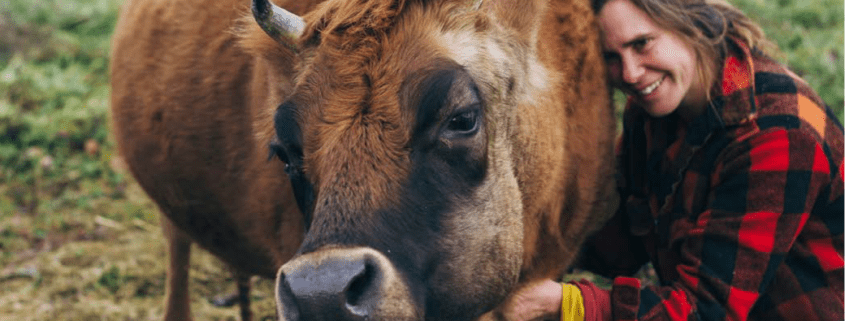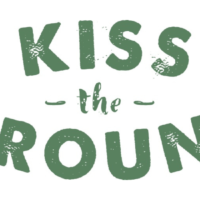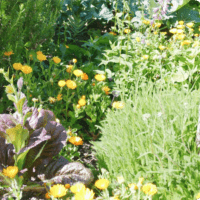Farming Empathy
Harvest Magazine Article – Spring 2018
Dairy farmer Laura Beck describes how farm individuality arises out of a farmer’s integration with her animals, land and community.
I’ve been playing with the idea of what farm individuality means for a few years now and letting the idea slowly evolve in my head and my senses.
When I first started this farm almost five years ago, I was whirring with the different, varied and many needs to get the farm and the business up and running. I didn’t give myself much space to sit and be present in the farm. But, slowly over the years, the daily rhythm has crept into the pulse of my body and there are times that I can see things in a new, fresh way. These times happen mostly when I am entirely present with the cows that live on the farm.
In my third year of farming here, I developed the sense that I inhabited the farm, that I was part of the herd, that I belonged. Not that I was cattle, but that I was seen and recognised and met by the herd. I was familiar and habitual, and our rubbing of shoulders every day over time meant that this connection happened.
Then, in my fourth season on the farm, I felt this beautiful sense that the farm inhabited me. That somehow it had my back. When I say ‘the farm’, I felt it distinctly as the animals and the land. I had formed such a strong habit body with my work on the land and with the animals that I felt that it knew me. I had this sense that I could fall back on it and it would hold me. Much like when I’m sick but still have to milk the cows, my body knows it so well that it can pull me through the process without my mind entering the bargain – helping me get through the morning.
I write about this connection because I think it is the will of the farmer and her or his sensibilities in relating to their animals and the land and nature which is absolutely critical in enabling or disabling the individuality and personality of the farm. It is the empathetic relationship the farmer has with the land and the animals which allows the individuality of the farm to express itself – because as humans, we have an incredible power to suffocate it either consciously or unconsciously.
I have learnt a lot from working with cattle. They have shaped and formed me in ways that I couldn’t have imagined. And they help hold me in rough times. Their consistency, their groundedness, their calmness helps return me to presence.
So, in shaping me, they help shape the farm and reveal its individuality.

This connection they have developed to me means that I can listen to them more and hear them more. In practice this means that I let them keep their calves for the first three months of their lives, because I feel not to do so would be abhorrent. It means that I choose to have all animals killed on- farm and not sent to the abattoir, because I believe abattoirs are inhumane. In this way, the farm is being shaped by an empathy with the cow, and this has a flow-on effect to the scale and economics of the farm and the community of the farm. It means that I only farm a few animals. It requires the people who eat and drink from the farm to pay a bit more for their milk, and to accept that when the calf is on the cow they get less cream (a result of the cow being suckled throughout the day by the calf). It impacts the rhythm of the day; I visit the herd every afternoon to bring the calves in for the night. This path shows me the farm in a different time of day, a different light; it lets me engage with the herd in a different way.
The cattle feel like the heart organ of the farm. Keeping cows with calves brings a sense of joy and completeness to the herd and farm. It feels like I am taking care of its heart. But, this is also constrained. I take the calves off after three months, because the farm wouldn’t be able to sustain itself financially
f I didn’t (by then the calves are drinking a lot of milk). I am exerting my will, governed by the dictates of economics, and this in turn shapes the feel of the farm – its personality, its individuality.
The farm cannot milk all year round. It can’t grow enough pasture, and I couldn’t sustain it. So in winter we all rest and hibernate. The farm’s individuality is reaching out into the community, telling them about the rhythmic season of growth. The folk who drink the milk from this farm have to respect and understand this. Some people go without, others buy alternatives – they are being farmed by the land too. And as a community we celebrate this. At the end of the milking season we have a simple ritual where people are invited to come and meet the cows and to thank them – we bring them food (apples, broccoli, cabbage, carrots etc.). Thanking the cows isn’t sweet or sentimental. It’s about recognising our connection with them – acknowledging how sacred it is to take another animal’s milk for our nourishment, and how intimate it is to drink it.
I guess this is a characteristic of the farm born from its individuality. How can we tell? Maybe because it feeds back into itself. The community of the farm support it far beyond paying money for milk. They come and grub gorse, volunteer for roles within the farm and business, give free professional advice, allow my mistakes with grace. All of these things mean that the farm survives.
Where I farm is not typical dairy country. The annual average rainfall is low, and without irrigation it is challenging to provide the quality of green feed that dairy cows need in order to produce well. So, I have started to shape the farm, informed by my relationship with the animals and by my understanding of nature. I have cultivated the land and resown the paddocks in a diverse, more drought-resilient pasture. These are deep- rooting, long-term herbal leys that mine nutrients from the soil, fix nitrogen and provide green feed for longer in dry weather. They have a seven-year rotation which reduces cultivation on what is a fragile loess-blown soil. Though the species I use aren’t native to the land here, they are working with the soil and the weather, reducing the amount of fertiliser input and giving the cattle a variety of feed. In
turn I am breeding towards cattle that are good foragers, are good producers, have overall good body composition and health, and are suited to the farm. I’m hoping that farming to the unique conditions of this farm means that the milk we produce has a flavour unique to this place.
I write this knowing that both the animals and cultivars, as well as some soil biology, are colonisers of this once bush- clad land. I don’t know how to let that speak out in the farm.
I do know that when I go and visit the slopes leading up to Taranaki Mountain they feel like they are crying out to be shod in native trees and shrubs and birds and beetles again.
I am young on this farm. I am beginning to learn what the land does after 200mm of rain over a couple of weeks.
Where the high spots are that the cattle can sleep and eat from, where the low points are that shouldn’t be seen by a hoof at that time. I can only imagine the connection and understanding that farmers have of their land that has been farmed for generations. In Europe, some farms are so old that when the world was smaller, the corners of the paddocks were named. The level of intimacy and knowing is so close and deep that some decisions around the farm must be just so intuitive. The land has taught them how to farm it.
My place as farmer almost feels like it becomes a conduit. I am being informed by the cattle, by the land and the weather, by my community, by economics, by politics and regulations. I am being farmed by these factors. In this I have to make the decisions that fit well enough with me. So my living questions are around what influences me, and what I can be open to be influenced by. What will I allow myself to be influenced by; what feels wrong; what feels right; what do I need to live well? As farmer, as human with the will to form and shape, it is the health of my relationship with these factors – my capacity to be honest in my answers – that helps to disable or enable the individuality of the farm.
When we farm biodynamically and with a sensitivity to the land and the animals, I think we are farming as truthfully as we can, and that this truth is distilled in the products of the farm, whether it be milk, meat, apples, broccoli or almonds. On this farm, the product isn’t being homogenised by the use of synthetic fertilisers, and nature isn’t being controlled with herbicides and pesticides. Pasture is grown and cattle are bred that best suit the region, soil and prevailing weather, in an attempt to try and work with nature while recognising what we need to eat and drink from the land. I think when we can do that with authenticity, there becomes a grace and ease to farming, and we are farming as truthfully as possible. Then we can enable the identity, the individuality, the personality of the farm to shine through – and we will be tasting that truth and uniqueness in our food and our drink.
Laura Beck is in her fifth year farming 22ha in Te Wharau, Charteris Bay on the Banks Peninsula. She works with cows to produce raw milk and beef to help feed her local community.





